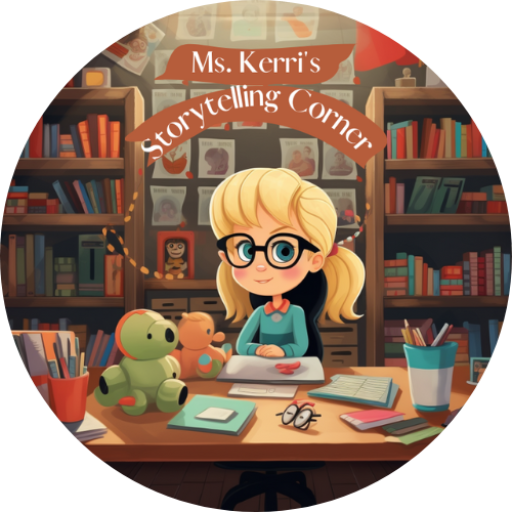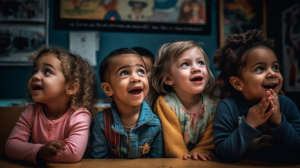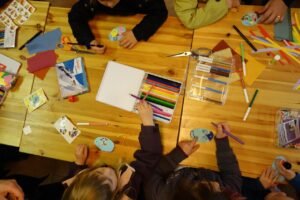Teaching sustainability to preschoolers through recycled crafts is an innovative way to instill environmental awareness from a young age. By engaging children in creative art projects using recyclable materials, we can nurture their eco-consciousness and foster a sense of responsibility towards the environment. This article explores the benefits of incorporating recycled crafts into preschool curriculum and provides key takeaways for educators and parents.
Key Takeaways
- Recycled crafts promote eco-consciousness in preschoolers
- Engaging in sustainable art projects fosters creativity and environmental awareness
- Teaching sustainability through art enhances learning experiences
- Incorporating recycled crafts into the curriculum encourages hands-on learning
- Choosing recyclable materials for crafts encourages exploration and creativity
Choosing Recyclable Materials for Crafts
Identifying suitable materials
When embarking on recycled crafts with preschoolers, it’s crucial to identify materials that are not only safe but also easy for little hands to manipulate. Safety and ease of use should be the top priorities when selecting recyclables for art projects. Common items like paper, cardboard, and fabric scraps are excellent starting points due to their versatility and low risk.
It’s essential to avoid materials that can pose choking hazards or contain harmful substances.
Materials can be categorized based on their origin and potential for reuse. Here’s a simple list to help you start:

- Paper products (newspaper, magazines, junk mail)
- Plastic containers (yogurt cups, plastic bottles)
- Metal items (tin cans, aluminum foil)
- Fabric scraps (old clothes, towels)
- Wood pieces (popsicle sticks, small blocks)
By carefully selecting materials, educators can ensure a safe and engaging crafting experience for preschoolers, fostering creativity while teaching the importance of recycling.
Exploring different types of recyclable materials
When it comes to crafting with preschoolers, the variety of recyclable materials available can spark endless creativity. Materials such as paper, cardboard, plastic bottles, and fabric scraps offer a wide range of textures and colors for little hands to explore and transform.
It’s essential to teach children the value of reusing materials, not only for their crafts but as a lifelong habit.
Here’s a brief overview of some common recyclable materials and their potential uses in crafts:
- Paper: Drawing, painting, or making paper mache.
- Cardboard: Building structures or creating puzzles.
- Plastic bottles: Making sensory bottles or decorative items.
- Fabric scraps: Sewing simple projects or making collages.
By introducing a variety of recyclable materials, educators can encourage children to think creatively about how they can repurpose items that might otherwise be discarded. This approach not only fosters creativity but also instills a sense of environmental responsibility from a young age.
Engaging Preschoolers in Sustainable Art Projects
Creating age-appropriate activities
When designing sustainable art projects for preschoolers, it’s crucial to ensure the activities are age-appropriate. Engaging young minds in sustainability can be both fun and educational if the projects are tailored to their developmental stage. For instance, simple crafting activities that involve sorting colors or shapes can introduce the concept of recycling in an accessible way.
It’s essential to create an environment where preschoolers feel encouraged to explore and express their creativity through sustainable materials.
Here are a few ideas to get started:
- Recycled paper collage: Children can tear or cut recycled paper into pieces and arrange them on a cardboard base.
- Egg carton garden: Using old egg cartons as planters, kids can learn about growing plants and the importance of reusing materials.
- Plastic bottle wind chimes: By decorating and assembling used plastic bottles, preschoolers can create beautiful wind chimes.
These activities not only teach the importance of recycling but also help in developing fine motor skills and fostering a sense of accomplishment.
Teaching the concept of sustainability through art
Teaching the concept of sustainability through art to preschoolers can be both engaging and enlightening. By incorporating recycled materials into art projects, children learn to see value in items that were previously considered waste. This not only fosters creativity but also instills a sense of responsibility towards the environment.

Art projects can range from simple to complex, depending on the age and skill level of the children. It’s important to choose activities that are not only fun but also convey the message of sustainability effectively.
- Create a collage using old magazines and newspapers.
- Construct sculptures from cardboard boxes and toilet paper rolls.
- Paint using natural dyes made from fruits and vegetables.
By engaging in these activities, children begin to understand the importance of recycling and reusing materials, which is a crucial step in teaching sustainability.
Incorporating these projects into the preschool curriculum encourages children to think critically about their environment and how they can contribute to its preservation. It’s a valuable lesson that will stay with them as they grow.
Benefits of Teaching Sustainability at a Young Age
Developing eco-consciousness in children
Instilling eco-consciousness in preschoolers is a foundational step towards nurturing a lifelong commitment to environmental stewardship. By integrating recycled crafts into their learning experience, children begin to understand the importance of sustainability from a young age. This hands-on approach not only makes the concept of recycling tangible but also fun and engaging.
It’s crucial to emphasize the relevance of recycling and how it directly impacts the world they live in.
Here are a few strategies to help develop eco-consciousness in children:
- Encourage them to ask questions about the environment and their role in protecting it.
- Demonstrate the process of recycling, from collection to transformation into new products.
- Highlight the importance of reducing waste and reusing materials whenever possible.
These activities foster a sense of responsibility and curiosity about the environment, paving the way for eco-friendly habits that can last a lifetime.
Fostering creativity and environmental awareness
Introducing preschoolers to recycled crafts not only nurtures their innate creativity but also instills a deep-seated respect for the environment. By using materials that would otherwise be discarded, children learn to see the world through a lens of possibility and innovation.
Boldly embracing recycled materials in art projects encourages children to think outside the box and develop unique solutions to problems. This approach not only fosters creativity but also enhances their environmental awareness.
Incorporating recycled crafts into art lessons can be as simple as:
- Collecting paper scraps for collage work
- Using old magazines for picture cutting
- Repurposing cardboard boxes into 3D art pieces
By engaging in these activities, children not only learn about the importance of recycling but also develop a sense of responsibility towards preserving our planet for future generations. It’s a win-win situation that benefits both the child’s development and the environment.
Incorporating Recycled Crafts into Preschool Curriculum

Integrating sustainability into lesson plans
Integrating sustainability into preschool curriculum involves more than just adding recycled crafts into the mix. It’s about weaving the concept of sustainability throughout the day’s activities, making it a seamless part of the learning experience. Teachers can start by incorporating simple, sustainable practices into everyday routines, such as recycling classroom waste or using both sides of paper for drawing.
Recycled crafts offer a hands-on way to explore sustainability, but they also serve as a springboard for discussions about why we recycle and how it helps the planet. By linking these activities to broader themes of environmental stewardship, children begin to see the connection between their actions and the world around them.
By making sustainability a part of the daily curriculum, educators can foster a sense of responsibility and care for the environment in young learners.
Here are a few ideas to get started:

- Introduce a ‘Material of the Week’ that focuses on a different recyclable material.
- Organize a classroom recycling center where children can sort materials.
- Plan a ‘Green Day’ where lessons revolve around environmental themes.
Enhancing learning through hands-on activities
Integrating hands-on activities into the preschool curriculum not only enhances learning but also solidifies the understanding of sustainability among young learners. By engaging in recycled crafts, children can see and feel the materials, making the concept of sustainability more tangible and meaningful.
Bold emphasis on practical application helps to bridge the gap between theoretical knowledge and real-world application, ensuring that the lessons learned are not only remembered but also applied.
Recycled crafts offer a unique opportunity to incorporate creativity and environmental awareness into everyday learning. Here’s a simple list to get started:
- Collecting and sorting recyclable materials
- Brainstorming ideas for new projects
- Creating art with recycled items
- Reflecting on the importance of recycling and sustainability
By following these steps, educators can create a dynamic and interactive learning environment that fosters a deep understanding of sustainability from a young age.
Conclusion
In conclusion, teaching sustainability through recycled crafts is a fun and effective way to instill environmental awareness in preschoolers. By engaging in art projects that utilize recycled materials, children learn the importance of reducing waste and protecting the environment. This hands-on approach not only fosters creativity but also encourages a sense of responsibility towards the planet. Through recycled crafts, preschoolers can develop a lifelong appreciation for sustainability and eco-friendly practices.
Frequently Asked Questions
What are some examples of recyclable materials suitable for preschooler crafts?
Examples of recyclable materials suitable for preschooler crafts include cardboard, paper rolls, plastic bottles, egg cartons, and yogurt cups. These materials can be transformed into various art projects, promoting sustainability and creativity.
How can preschoolers be engaged in sustainable art projects?
Preschoolers can be engaged in sustainable art projects by incorporating age-appropriate activities such as creating art with recycled materials, discussing the importance of recycling, and exploring nature-inspired crafts. These activities help children understand the concept of sustainability and environmental responsibility.
What are the benefits of teaching sustainability to preschoolers?
Teaching sustainability to preschoolers has several benefits, including developing eco-consciousness in children, fostering creativity, and promoting environmental awareness from a young age. It helps children understand the importance of preserving the environment and instills a sense of responsibility towards nature.
How can recycled crafts be integrated into the preschool curriculum?
Recycled crafts can be integrated into the preschool curriculum by incorporating sustainability into lesson plans, organizing hands-on activities using recycled materials, and linking art projects to environmental themes. This approach enhances learning experiences and encourages children to think critically about environmental issues.
What are some simple recycled craft ideas for preschoolers?
Simple recycled craft ideas for preschoolers include making paper roll animals, creating cardboard sculptures, designing bottle cap art, and crafting flower pots from recycled containers. These activities are not only fun and engaging but also teach children the value of reusing materials and reducing waste.
How can parents and educators support sustainable art practices for preschoolers?
Parents and educators can support sustainable art practices for preschoolers by providing access to recyclable materials, encouraging creative reuse of everyday items, and discussing the importance of environmental conservation. By involving children in eco-friendly art projects, they can instill a sense of responsibility towards the environment.


Ms. Kerri’s Corner provides a exciting virtual space for preschool learning. Through a variety of engaging activities, she exposes young minds to early math, literacy, science and social-emotional skills in a developmentally appropriate way. Centers for blocks, art, books and music allow children to explore hands-on learning at their own pace. Guided lessons subtly introduce number sense, letter sounds and narrative thinking. Careful observation gives insight into each child’s progress across domains. Viewers are also invited to participate, reinforcing that their ideas are valued. By making learning fun yet purposeful, Ms. Kerri lays the groundwork for future academic success while fostering creativity and imagination. Her program offers preschoolers valuable screen-based learning experiences.




